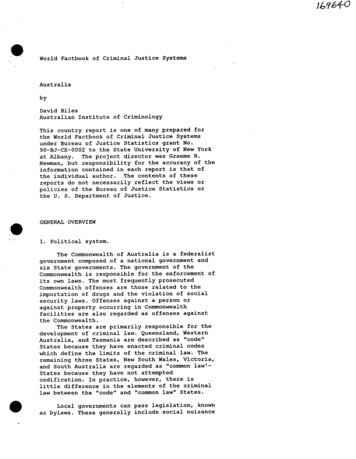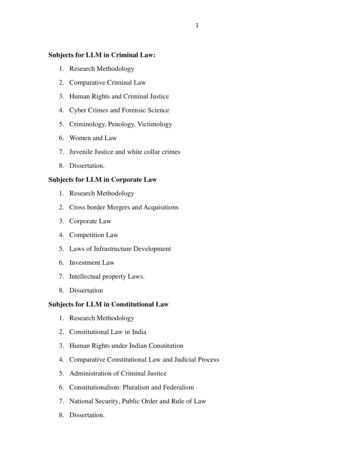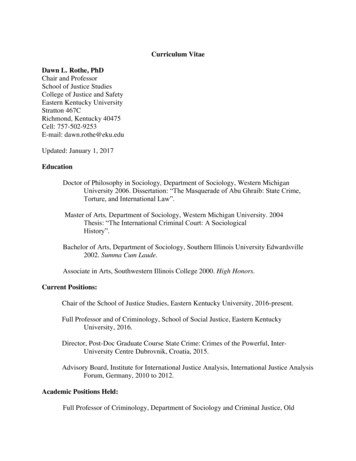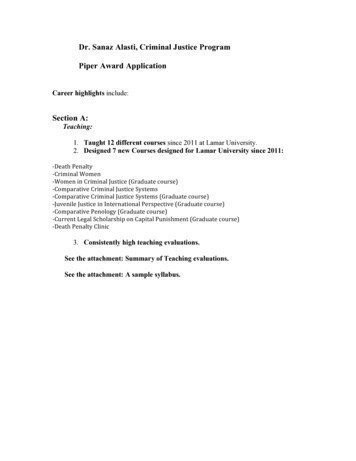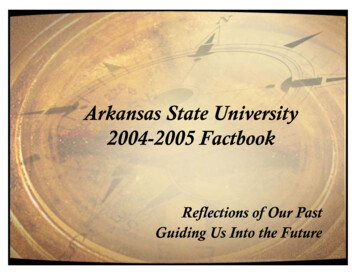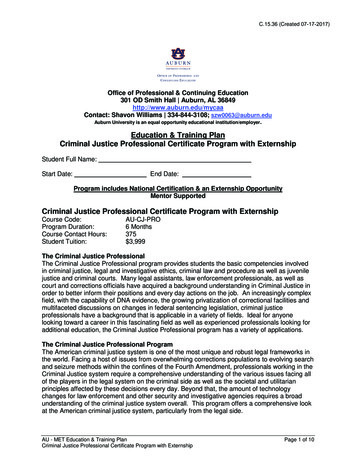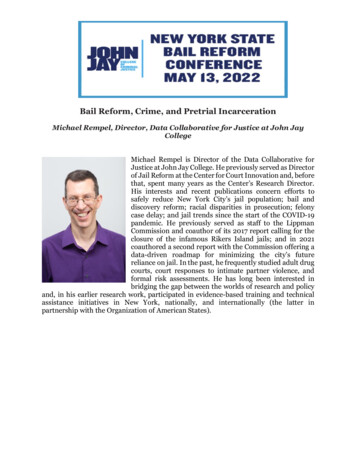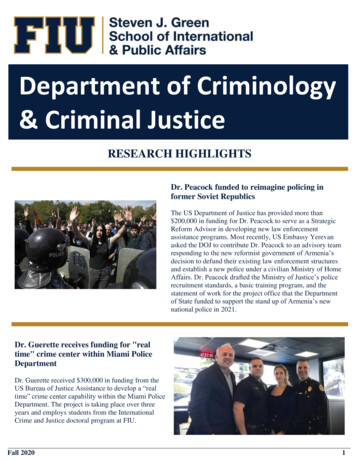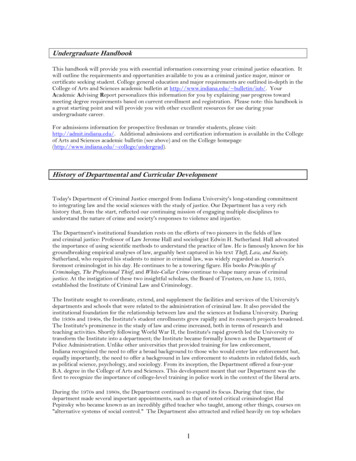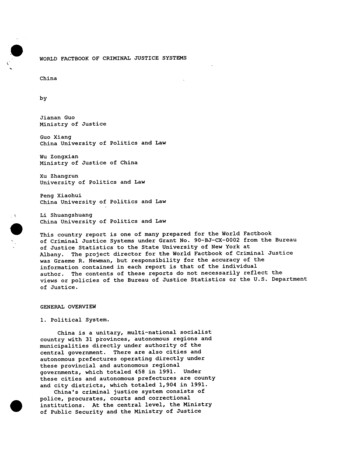
Transcription
WORLD FACTBOOK OF CRIMINAL JUSTICE SYSTEMSChinabyJianan GuoMinistry of JusticeGuo XiangChina Universityof Politicsand LawWu ZongxianMinistry of Justice of ChinaXu ZhangrunUniversity of Politicsand LawPeng XiaohuiChina Universityof Politicsand LawLi ShuangshuangChina Universityof Politicsand LawThis country report is one of many prepared for the World Factbookof Criminal Justice Systems under Grant No. 90-BJ-CX-0002 from the Bureauof Justice Statistics to the State University of New York atAlbany.The project director for the World Factbook of Criminal Justicewas Graeme R. Newman, but responsibility for the accuracy of theinformation contained in each report is that of the individualauthor.The contents of these reports do not necessarily reflect theviews or policies of the Bureau of Justice Statistics or the U.S. Departmentof Justice.GENERAL OVERVIEWi. PoliticalSystem.China is a unitary, multi-national socialistcountry with 31 provinces, autonomous regions andmunicipalities directly under authority of thecentral government.There are also cities andautonomous prefectures operating directly underthese provincial and autonomous regionalgovernments, which totaled 458 in 1991.Underthese cities and autonomous prefectures are countyand city districts, which totaled 1,904 in 1991.China's criminal justice system consists ofpolice, procurates, courts and correctionalinstitutions.At the central level, the Ministryof Public Security and the Ministry of Justice
administer China's police and correctionalinstitutions, respectively.The Supreme People'sCourt is the highest judicial branch in thecountry.The Supreme People's Procurate is thehighest state branch of legal supervision, withprosecution as its main function.The policedepartments or bureaus, the justice departments orbureaus, procurates and courts at various levelsare established to fulfill their respective dutiesin their own jurisdictions.2. Legal System.The legal system of the People's Republic ofChina is typically Marxist.As declared under thefirst article of the Criminal Law, Marxist Leninist - Mao Zedong Thought are the guidingprinciples of the present law.The legislators inthe People's Republic of China view laws,especially criminal laws, as the tool of theruling class (synonymous with the state), to beused as a coercive force to repress the ruled.The criminal law represents the interests of theruling class, which defines certain acts as crime.In judicial activities, public securitybranches, people's procurates and people's courtshave a division of labor with separateresponsibilities and checks and balances toguarantee the accurate and effective enforcementof the law.The public security branches areresponsible for the investigation, detention, andpreparatory examination of criminal cases.Thepeople's procurates are responsible for approvingarrest, conducting procuratorial work (includinginvestigation) and initiating public prosecution.The people's courts are responsible foradjudication.The prison or other places ofreform through labor are responsible for sentenceexecution.No other branch, organization, orindividual has the right to exercise their powers.An informal justice system, the People'sMediation of Disputes, does play a significantpart in the justice system.However, onlycriminal cases of private prosecution can besettled through mediation in the court.3. History of Criminal Justice System.Historically, each dynasty in China had theirown written statutes and customary laws comprisingtheir criminal law.Famous ancient criminalstatutes include the Yuxing criminal laws of theXia Dynasty, the Tandxing criminal laws of theShang Dynasty, the Jiuxing criminal laws of theZhou Dynasty, the Qinlu laws of the Qing Dynasty,the Hanlu laws of the Han Dynasty, the Tanglu lawsof the Tang Dynasty, the Daminglu criminal code of
the Ming Dynasty, and the Daqing luli criminalcode of the Qing Dynasty.The commoncharacteristic among these dynasties was thattheir criminal justice systems were operated byadministrative officials.With the establishment of the People'sRepublic of China in 1949, a new political era wasborn in China's 5,000 year history.When theCommunist Party came into power for the first timein China, one of its first priorities was toabolish the laws enacted by the old government andreplace them with new ones.Upon invalidating the6 laws of the Kuomintang regime in February, 1949(e.g. Constitution, Civil Law, Commercial Law,Criminal Law, Civil Procedure Law, and CriminalProcedure Law), the new government began toconstruct a socialist legal system.In 1954, the Constitution of the People'sRepublic of China was adopted at the NationalPeople's Congress, the highest legislative body ofthe country.That same year, legislation onReform Through Labor of the People's Republic ofChina was adopted and in 1957, legislation onPolice of the People's Republic of China wasadopted.Meanwhile, drafts of new laws such asCriminal Law, Civil Law, Criminal Procedure Law,and Civil Procedure Law were prepared andcontinually revised.The "Cultural Revolution" initiated in 1966broke off the course of legal construction inChina.Twelve years later, the Third PlenarySession of the llth Central Committee of theChinese Communist Party held in December, 1978,decided to end the "Cultural Revolution" campaignand put great emphasis on the institutionalizationand legislation of the socialist democracy and onthe stability, continuity and authority of law.Thereafter, legal reconstruction began in China.After the draft was revised more than 30 times,the Criminal Law of the People's Republic of Chinawas finally adopted at the 2nd session of the 5thNational People's Congress in July, 1979. TheCriminal Procedure Law of the People's Republic ofChina was also adopted at the same session in1979.It took 30 years for the People's Republic ofChina to enact its first laws.Until 1979 therewere no legal standards to guide judges to trycriminals.As a supplement to the Criminal Law, aspecial law called The Interim Regulations of thePeople's Republic of China Concerning thePunishment of Servicemen in Violation of theirDuty, and 12 other amendments to the Criminal Lawhave been adopted by National People's Congress.In 1982, amendments to the Constitution of thePeople's Republic of China were adopted and in1990, the Decision of the Standing Committee of
the National People's Congress Regarding theProhibition of Drugs was established.CRIMEI. Classification of Crimes.* Legal classification.In the Criminal Law,crimes are classified into eight categoriesaccording to the object of the crime: i) crimes ofcounterrevolution, which are crimes endangeringthe People's Republic of China such as treason,espionage, and mass rebellion; 2) crimes ofendangering public security, which are crimesendangering the life and wealth of many people, aswell as the security of public and privateproperty, such as arson, breach dikes, explosions,spreading poison, causing traffic accidents,illegal manufacturing, trading in or transportingguns or ammunition, and causing major productiveaccidents; 3) crimes of undermining the socialisteconomic order, which includes smuggling,speculation, falsely passing off trade marks, andillegally chopping down trees; 4) crimes ofinfringing upon the right of the person and thedemocratic rights of citizens, such as homicide,bodily injury, rape, forcing women intoprostitution, abducting and selling people,unlawful detention of another person, unlawfulintrusion into another person's residence, falselyaccusing and framing, defamation, insult andhumiliation, giving false evidence or testimony,and using torture to coerce a statement; 5) crimesof property violation, such as robbery, stealing,swindling, corruption, and extortion by blackmail;6) crimes of disrupting social order, such asdisrupting public affairs, official documents,certificates or seals, harboring criminals,concealing stolen goods, hooligan activities, andgambling; 7) crimes of disrupting marriage and thefamily, such as bigamy, abuse of a family member,abandonment, and abducting a child; and 8) crimesof dereliction of duty, such as bribery andsubjecting imprisoned persons to corporalpunishment and abuse.In addition, Criminal Procedure Lawcategorizes crimes into Crimes of PublicProsecution and Crimes of Private Prosecution.* Age of criminal responsibility.The age ofcriminal responsibility is 16. However, a personbetween the ages of 14 and 16 who commitshomicide, infliction of serious bodily injury,robbery, arson, habitual theft, or any other crimewhich seriously undermines the social order bearsfull criminalresponsibility.Under this
circumstance, the severity of the punishment islighter or mitigated.The death penalty is notallowed to be imposed on a person under the age of18.When a person is not punished because he orshe is under 16 years-old, the head of the familyor guardian is ordered to subject the person todiscipline.When necessary, the person may alsobe given shelter and rehabilitation by thegovernment.* Drug offenses.Drug offenses as defined in theCriminal Law include the manufacturing, sellingand transportation of drugs.Heroin and opium arethe most prevalent drugs that are sold.Usingdrugs is not a criminal offense.As an amendmentto the Criminal Law, the Decision of the StandingCommittee of the National People's Congress on theStrict Prohibition Against Narcotic Drugs includesholding drugs (possession) or taking actions tolure, instigate, deceive and/or force others touse drugs as among drug-related crimes.2. Crime Statistics.Until 1986, crime statistics had not beendisclosed to the public.In 1987, the Ministry ofPublic Security presented the first group of crimestatistics data in the China Law Yearbook of 1987.The data included statistics from 1981 to 1986 andwas compiled by the China Law Society, which hasthereafter published updates of criminal justicedata every year.The data presented by theMinistry included the number of crimes recorded bythe police, the rates of recorded crime and thenumber of arrests made by the police.The following data are from the Chinese Lawyearbook (1991, 1992).The offenses are based onadministrative definitions used by the publicsecurity branches.* Murder.There were 23,199 murders recorded bythe police in 1991 (The number of murders recorded by police inprevious years are as follows:21,214 (1990);19,590 (1989); 15,959 (1988); 13,154 (1987);11,510 (1986); 10,440 (1985); 9,021 (1984); 10,353(1983); 9,324 (1982); and 9,576 (1981)).Attempts are included.* Rape.There were 50,331 cases of rape recordedby the police in 1991 (The number of rape cases reported by policeprevious years are as follows:47,782 (1990);40,909 (1989); 34,120 (1988); 37,225 (1987);39,121 (1986); 37,712 (1985); 44,630 (1984);57,914 (1983); 35,361 (1982); and 30,808 (1981)).Attempts are included.* Theft.There were 1,922,506cases of larcenyin
recorded by police in 1991 (The numberof larceny cases recorded by policein previous years are as follows:1,860,793(1990); 1,673,222 (1989); 658,683 (1988); 435,235(1987); 425,845 (1986); 431,323 (1985); 395,319(1984); 571,255 (1983); 609,481 (1982); and744,376 (1981)).Attempts are included.* Drug offenses.There were 8,344 drug offensecases recorded by the police in 1991, at a rate of.70 per 100,000 population.Attempts are notincluded.* Crime regions.The crime rate is much higher inthe South East Coastal provinces which is a moreopen, economically prosperous and denselypopulated area.Most drug offenders are from theYunnan Province and Guangxi Autonomous Region inSouth West China.Both areas are close to theGolden Triangle Area, one of the mostnotabledrug sources in the world.Generally, the overall crime rate in citiesis much higher than the rural areas.The crimesof abducting women and children are higher in therural areas of Sichuan Province, Henan Province,Shandong Province than other rural provinces.Also coastal areas, such as the GuangdongProvince, Fujian Province, Zhejiang Province andShenzhen Special District, have higher crime ratesthan landlocked areas.VICTIMSI. Groups Most Victimized by Crime.The first victimization survey is presentlybeing planned with technical and financialassistance from the United Nations InterregionalCrime and Justice Research Institute.2. Victims'Assistance Agencies.China has not established victims' assistanceagencies, but some organizations for youth andwomen have provided economic and legal aid andpsychological counseling.Also, some mentalhealth departments as well as psychologists,psychiatrists, and sociologists have establishedmental clinics or hot-line telephones forpsychological counseling.In addition, criminal law stipulates, "Wherethe victim has suffered economic loss as a resultof a criminal act, the criminal element, inaddition to receiving criminal sanction accordingto law, shall in accordance with the circumstances
be sentenced to make compensation for the criminalloss."3. Role of V i c t i m in Prosecution and Sentencing.Victims of crime have the right to bring acomplaint and the right to give evidence.Theyalso have the right to claim economiccompensation, through a supplementary civilaction. A victim can bring a charge against acriminal in private prosecution cases andintervene in the court as a third party in publicprosecution cases.If the victim does not agreewith judgments or orders of the court, he or shehas the right to appeal to a higher court inprivate prosecution cases or may petition thecourt or the procurate in the public prosecutioncases.4. Victims'Rights Legislation.China has not passed any special victim'scomprehensive legislation.POLICEi. Administration.In the People's Republic of China, the policeagencies include the Ministry of Public Securityat the central level, the local public securitybureaus at various levels and public securityforces for railways, highways, navigation, airtransport, forests and other fields.Theorganizational structure from top to b o t t o m is:Ministry of Public Security, Provincial PublicSecurity Departments/Bureaus, Prefectural PublicSecurity Departments/Bureaus, County PublicSecurity Bureaus, Local Police Stations.Inaddition, the Public Security Offices of Ministryof Railways and Public Security Offices ofMinistry of Communications also fall under theauthority of the Ministry of Public Security.The Ministry of Public Security, whichoperates under the State Council, is the highestpolice agency in the country.Local publicsecurity agencies are responsible for the publicsecurity in their respective localities under thedual leadership of local government and higherpublic agencies.The public security forces forrailways, highways, navigation, air transport,forests and other special fields are under theadministrative leadership of their respectiveministries or departments and the professionalleadership of higher public security agencies.They cooperate closely with the local publicsecurity agencies.
The Chinese People's Armed Police is a partof the armed forces in the country, a component ofthe public security force and a branch of thePeople's police under the leadership of TheCentral Military Commission and the Ministry ofPublic Security.The local armed police are underthe leadership of the local public securityagencies and higher organizations of the armedpolice.Their principal duties include innerguard, frontier control and inspection, exit andentry control, as well as fire-fighting.2. Resources.* Expenditures.Information not available.* Number of police.In 1991, there were a totalof 1,484,000 police officers, of which 825,000were people's policemen and 659,000 were armedpolicemen.3. Technology.* Availability of police automobiles.On theaverage, every police station with at least 7 or 8policemen has one car.The higher the number ofpolicemen in the agency, the higher the number ofcars.Most police automobiles are made in China.* Electronic equipment.The Science andTechnology Bureau, operating under the Ministry ofPublic Security, is in charge of nationalscientific and technical administration that isrelated to the public security.Computers areextensively used in criminal investigation,traffic control and communication.A fingerprintsearch system was computerized in 1986.In 1987,a special police communication network linking allthe police agencies at the county level and abovewas established.A radio communication network atprovincial level was also established in the1980s.* Weapons.Police weapons include the baton,police rope, handcuffs, tear-gas, grenades,pistols, and semi-automatic rifles.Althoughbulletproof vests are available to police,information on the police to vest ratio isunavailable.4. Training and Qualifications.Most police officers graduate from the policeuniversities of the country or the policeacademies of provinces.Under specialcircumstances, police agencies can also recruitnew staff from individuals who do not have a
diploma of police u n i v e r s i t i e s or schools.It isrequired, however, for an applicant to be agraduate of senior high school or university, beunder the age of 25, and have a strong physique.There are d i f f e r e n t levels of t r a i n i n ginstitutions.The colleges or academies which arerun by the M i n i s t r y of Public S e c u r i t y train thedirectors of p u b l i c s e c u r i t y (or bureaus) ofprovinces, autonomous regions and m u n i c i p a l i t i e s .The colleges and schools at the level of province,autonomous region and municipality, train thedirectors of county p u b l i c security bureaus, theleaders of the p u b l i c security b r a n c h bureaus inthe m u n i c i p a l i t i e s and the leader's subordinates,such as section chiefs and squad heads.Schoolsa t t a c h e d to the p r e f e c t u r e s and m u n i c i p a l i t i e sunder the p r o v i n c i a l g o v e r n m e n t train sectionchiefs, station leaders, squad heads and otherpolice officers.T r a i n i n g periods last for an average of sixmonths and vary for d i f f e r e n t trainees.5. Discretion.* Use of force.The criminal police carrypistols, batons, and handcuffs when p e r f o r m i n gtheir duties.They are p e r m i t t e d to use guns tostop a crime or d e f e n d themselves.Specifically,they can use d e a d l y force as a last resort to stopsituations where I) the offender tries to resistor escape apprehension, steals weapons carried bypolice, or attacks police officers while beinga r r e s t e d or detained; (2) the offender is in theprocess of c o m m i t t i n g a violent crime and p u t t i n gcitizens' lives in danger; (3) the o f f e n d e r isa t t a c k i n g an object under guard by the police; (4)a group of offenders raid a p r i s o n and/orprisoners are escaping, rioting, murdering, orstealing guns from s e c u r i t y officers; or (5) theoffender p h y s i c a l l y threatens the life of a p o l i c eofficer.Before using their pistols, they mustissue an oral w a r n i n g or fire a w a r n i n g shot.Only when these warnings do not affect thecriminal behavior, can p o l i c e fire the pistol.* S t o p / a p p r e h e n d a suspect.Under the followingcircumstances, the p o l i c e can detain an i n d i v i d u a lwho, d e p e n d i n g on the nature of the crime, hasbecome a major suspect and/or should be arrested:(I) the p e r s o n is p r e p a r i n g to commit a crime, isc o m m i t t i n g a crime or is d i s c o v e r e d i m m e d i a t e l yafter c o m m i t t i n g a crime; (2) the p e r s o n isi d e n t i f i e d as having c o m m i t t e d a crime by a v i c t i mor eyewitness; (3) the p e r s o n is d i s c o v e r e d tohave criminal evidence on his person or at hisresidence; (4) the p e r s o n attempts to commitsuicide, to escape or becomes a fugitive after
c o m m i t t i n g the crime; (5) the p e r s o n has theo p p o r t u n i t y to d e s t r o y or f a l s i f y e v i d e n c e orcollude w i t h others to d e v i s e a false a c c o u n t ofevents; (6) the p e r s o n ' s true i d e n t i t y is u n k n o w nand is s u s p e c t e d of c o m m i t t i n g crimes in s e v e r a lg e o g r a p h i c areas; or (7) the p e r s o n is "beating,s m a s h i n g and l o o t i n g " and u n d e r m i n i n g work,p r o d u c t i o n or the social order.* D e c i s i o n to arrest.The p o l i c e can a r r e s t asuspect w i t h a w a r r a n t i s s u e d by the C h i e fProsecutor.* S e a r c h and seizure.The p o l i c e m a y c o n d u c tsearches of the persons, articles, r e s i d e n c e s andother r e l e v a n t places of d e f e n d a n t s for thep u r p o s e of g a t h e r i n g c r i m i n a l e v i d e n c e anda p p r e h e n d i n g criminals.T h e y m a y also s e a r c hp e o p l e b e l i e v e d to be h i d i n g criminals or c r i m i n a levidence.B e f o r e c o n d u c t i n g such a search,o f f i c e r s m u s t show a search w a r r a n t to the p e r s o nto be searched.A s e a r c h m a y be c o n d u c t e d w i t h o u t a s e a r c hw a r r a n t if an e m e r g e n c y arises d u r i n g the a r r e s tor d e t e n t i o n process.The suspect, familymembers, n e i g h b o r s or other e y e w i t n e s s are u s u a l l yp r e s e n t d u r i n g the search.If a r t i c l e s ord o c u m e n t s are d i s c o v e r e d that can be u s e d to p r o v eguilt or innocence, they are u s u a l l y e x a m i n e d bye y e w i t n e s s e s and/or the p e r s o n b e i n g searched.A f t e r the search, an i n v e n t o r y of the s e i z e d itemsis m a d e in d u p l i c a t e with one copy g i v e n to thep e r s o n who was searched.* Confessions.A c c o r d i n g to the C r i m i n a lP r o c e d u r e Law, it is p r o h i b i t e d to use t o r t u r e tocoerce c o n f e s s i o n s or gather e v i d e n c e t h r o u g hthreats, enticement, d e c e i t or other u n l a w f u lmethods.I n t e r r o g a t i o n of the d e f e n d a n t m u s t bec o n d u c t e d by the i n v e s t i g a t i o n p e r s o n n e l of thep e o p l e ' s p r o c u r a t o r a t e s or the p u b l i c s e c u r i t ybranches.No fewer than 2 i n v e s t i g a t i o n p e r s o n n e lm a y be p r e s e n t d u r i n g i n t e r r o g a t i o n .Wheni n t e r r o g a t i n g a defendant, i n v e s t i g a t i o n p e r s o n n e lshall first ask the d e f e n d a n t w h e t h e r he or shee n g a g e d in a c r i m i n a l act and then let thed e f e n d a n t state the c i r c u m s t a n c e s of guilt orinnocence.The d e f e n d a n t m u s t a n s w e r thei n v e s t i g a t i o n p e r s o n n e l ' s q u e s t i o n s a c c o r d i n g tothe facts, but has the right to refuse to a n s w e rq u e s t i o n s that have no r e l a t i o n to the case.Ap e r s o n who is p r o f i c i e n t in sign l a n g u a g e m u s tp a r t i c i p a t e in the i n t e r r o g a t i o n of a deaf or m u t edefendant, and a clear t r a n s c r i p t is to be m a d e ofsuch c i r c u m s t a n c e s .
6. A c c o u n t a b i l i t y .Complaints against p o l i c e m i s b e h a v i o r areh a n d l e d by the s u p e r v i s o r y b u r e a u or sectionswithin the M i n i s t r y of Public S e c u r i t y or lowerp u b l i c s e c u r i t y branches.A n y citizen m a yp r o s e c u t e the illegal b e h a v i o r of p o l i c e officersand b r i n g the case to a people's p r o c u r a t e or apeople's court, and can initiate p e t i t i o n to thehigher p u b l i c s e c u r i t y branch.The criminal lawstipulates, ".the use of torture to coerce astatement is s t r i c t l y prohibited.State p e r s o n n e lwho inflict torture on an offender to coerce astatement are to be s e n t e n c e d to not more than 3years of f i x e d - t e r m i m p r i s o n m e n t or criminaldetention.W h o e v e r causes a person's i n j u r y ord i s a b i l i t y t h r o u g h corporal p u n i s h m e n t is to beh a n d l e d under the crime of injury and given ah e a v i e r p u n i s h m e n t . " (Article 136).PROSECUTORIALI. RightsA N D JUDICIALPROCESSof the Accused.* Rights of the accused.In addition toe x e r c i s i n g the right to d e f e n d themselves,defendants m a y also a u t h o r i z e the following p e o p l eto d e f e n d them: a) lawyers; b) citizensr e c o m m e n d e d by a people's o r g a n i z a t i o n or thedefender's unit, or who are a u t h o r i z e d by thepeople's court; or c) close relatives or guardiansof the defendant.The accused also has the rightof knowing the nature of the accusation, the rightto p a r t i c i p a t e in p r o c e e d i n g s in his or her nativespoken and w r i t t e n language, to apply for newexpert e v a l u a t i o n or i n s p e c t i o n during thec o u r t r o o m hearing, the right to request the chiefjudge to ask certain questions to w i t n e s s e s orelse ask them directly, the right to m a k e a finalstatement after the chief judge has a n n o u n c e d theclosing of the debate, the right to raise ac o u n t e r c l a i m against the p r i v a t e p r o s e c u t o r in acase of p r i v a t e p r o s e c u t i o n and the right torequest that m e m b e r s of the judicial panel, thecourt clerk, the public prosecutor, expert witnessor i n t e r p r e t e r s w i t h d r a w from the case.The a c c u s e d also has the right to appeal andthe right to p e t i t i o n judgments or orders, whichhave become l e g a l l y effective, to the people'scourts or the people's p r o c u r a t e sIn cases where the p u b l i c p r o s e c u t o r appearsin court to bring a p u b l i c p r o s e c u t i o n and thed e f e n d a n t has not a u t h o r i z e d anyone to be his orher defender, the people's court m a y d e s i g n a t e adefender.If the d e f e n d a n t is deaf, mute, or aminor and has not a u t h o r i z e d a defender, the
p e o p l e ' s court d e s i g n a t e s a defender.Thed e f e n d e r p r e s e n t s m a t e r i a l s and o p i n i o n sd e m o n s t r a t i n g the i n n o c e n c e of the defendant.or she can also argue that the crime was m i n o rthat the d e f e n d a n t s h o u l d r e c e i v e m i t i g a t e dp u n i s h m e n t or be e x e m p t e d from c r i m i n a lr e s p o n s i b i l i t y , s a f e g u a r d i n g the lawful rightsi n t e r e s t s of the defendant.D u r i n g thea d j u d i c a t i o n process, the d e f e n d a n t m a y refusehave a d e f e n d e r c o n t i n u e and a u t h o r i z e a n o t h e rd e f e n d e r instead.Heorandto* A s s i s t a n c e to the accused.A n a c c u s e d ise n t i t l e d to call upon the a s s i s t a n c e of a d e f e n s el a w y e r of his or her own choice.In p u b l i cp r o s e c u t i o n cases, the court will d e s i g n a t e ad e f e n s e a t t o r n e y if the d e f e n d a n t has not a l r e a d ya u t h o r i z e d an a t t o r n e y for his or her defense.2. Procedures.* P r e p a r a t o r y p r o c e d u r e s for b r i n g i n g the s u s p e c tto trial.A f t e r a suspect is arrested, family orl i v i n g p a r t n e r s are n o t i f i e d w i t h i n 24 hours a l o n gwith the reasons for his arrest and the p l a c e ofcustody.N o t i f i c a t i o n does not o c c u r in casesw h e r e it w o u l d h i n d e r the i n v e s t i g a t i o n or thep a r t i e s are not able to be reached.A f t e r the p o l i c e i n v e s t i g a t e an offense, t h e ydraft an o p i n i o n w h i c h e i t h e r r e c o m m e n d sp r o s e c u t i o n or e x e m p t i o n from p r o s e c u t i o n .Theythen t r a n s f e r the opinion, case file m a t e r i a l s ,and e v i d e n c e to the p r o c u r a t e at the same levelfor review.The p r o c u r a t e then reviews the caseand m a k e s a d e c i s i o n on w h e t h e r to p r o s e c u t e thesuspect.If a d e c i s i o n is made to p r o s e c u t e thesuspect, the p r o c u r a t e then i n i t i a t e s a p u b l i cp r o s e c u t i o n in the court at the same level.Thecourt will r e v i e w the case p r o s e c u t e d by theprocurate.If the facts of the case are clear andthe e v i d e n c e is sufficient, the court can d e c i d eto open the court s e s s i o n for a d j u d i c a t i o n , inw h i c h the s u s p e c t is f o r m a l l y b r o u g h t to trial.The p r o c u r a t e can also grant e x e m p t i o n fromp r o s e c u t i o n for c e r t a i n m i n o r crimes.* O f f i c i a l who conducts p r o s e c u t i o n .A m e m b e r ofthe P e o p l e ' s Procurate, an i n d e p e n d e n t b r a n c h ofthe c r i m i n a l justice system, conducts thep r o s e c u t i o n of the accused.* Alternativesavailable.to going to trial.I n f o r m a t i o n not* P r o p o r t i o n of p r o s e c u t e d cases going to trial.Data i n d i c a t e that 83% of the p r o s e c u t e d cases
went to trial in 1991.In that year, thep r o c u r a t e g r a n t e d e x e m p t i o n to 48,180 cases w h i c hwere r e c o m m e n d e d for p r o s e c u t i o n by the police.* P r e - t r i a l i n c a r c e r a t i o n conditions.Police m u s tconduct an i n t e r r o g a t i o n of the d e t a i n e d p e r s o nw i t h i n 24 hours of b e i n g h e l d in custody.Ifthere are no grounds found for detention, thed e t a i n e d p e r s o n m u s t be r e l e a s e d immediately.If the p o l i c e c o n s i d e r it n e c e s s a r y to a r r e s ta d e t a i n e d person, they can r e q u e s t the p r o s e c u t o rto issue a w a r r a n t w i t h i n three days a f t e rdetention.The p r o s e c u t o r m u s t m a k e the d e c i s i o nto a p p r o v e or d i s a p p r o v e this arrest w i t h i n threedays.If the p r o s e c u t o r does not a p p r o v e thearrest, the p o l i c e are r e q u i r e d to r e l e a s e thedetained person immediately after receivingnotice.The p e r i o d for h o l d i n g an a r r e s t e e in c u s t o d yd u r i n g i n v e s t i g a t i o n m a y not e x c e e d two months.This p e r i o d can be e x t e n d e d for
of Criminal Justice Systems under Grant No. 90-BJ-CX-0002 from the Bureau of Justice Statistics to the State University of New York at Albany. The project director for the World Factbook of Criminal Justice was Graeme R. Newman, but responsibility for the accuracy of the
